Neoregelia Marie
Click thumbnails for full size, scaled to a new window.
Neoregelia Marie
cv. of olens commonly called 'Vulcan' but changed to olens 'Marie' for Marie Picard's fine clearly colored compact cultivar.(Uncle Derek), by Picard.M. & Read
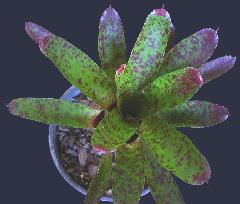
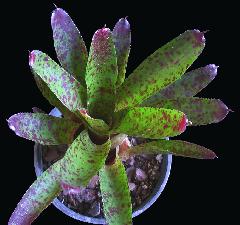
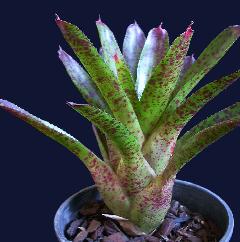
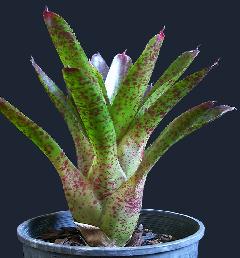
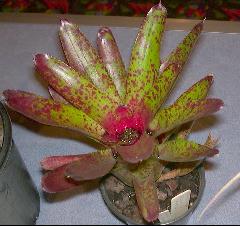
| Ian Hook, 06/04, owned by R.Farrugia. |
An Editorial Comment by Tom Lineham in J. Brom. Soc. 36(4): 167-170. 1986
Some time ago, Derek Butcher of Fulham, South Australia, asked us to try to resolve the relationship of Neoregelia olens, various plants named "696," "Vulcan," and "Vulkan." To add to the problem he wanted to know where Neoregelia `Pepper' got its spots.
Mr. Butcher prefaced his letter with an excerpt from an article by Harry E. Luther, "Note on Neoregelias," which appeared on page 223, volume 33 of the Journal in 1983:
N. olens (Hook, f.) L.B. Smith, 1939. Botanically known from the original description and plate with at least 3 distinct clones in cultivation. Often grown as `Vulcan' or `696'.
Mr. Butcher explained that he had acquired a Neoregelia "696" in Los Angeles and that he had seen a Neoregelia olens “Vulcan" in Grace Goode's garden' without recognizing a relationship between the two plants.
He commented on the similarities and differences, suggesting that climate might have an effect. He specifically mentioned that Grace Goode's "Vulcan" leaves were lime- green and a very high proportion of dark pinkish-red splashes and spots, and then listed as contributing to his confusion the following references:
• Dr. Lyman B. Smith's description of N. olens in his Bromelioideae, page 1551, and the reference to the Botanical Magazine, volume 91, pl. 5502, 1865 (please refer to page 152).
• The BSI International Checklist of Hybrids (1979), page 45, concerning the parentage of N. `Pepper'.
• Dr. Werner Rauh's plate 104, illustrating N. olens, in his Bromeliads for Home, Garden, and Greenhouse (with D.B.'s notation that neither Dr. Rauh nor Dr. Smith mentioned the presence or absence of spots).
Matters such as this are not answered offhand and here we have the opportunity to clear up the mystery and to emphasize again the need for paying careful attention to nomenclature, and for registering both hybrids and cultivars. Two members of the Journal editorial advisory board, Dr. R.W. Read and Mr. Harry E. Luther have contributed suggestions. We shall begin with Dr. Read because he was the first to identify the plants in question as Neoregelia olens.
Dr. Read: We must understand that Walter Richter gave the name Vulkan (with a "k") to a hybrid that had no relationship to Neoregelia olens. Walter Richter's Vulkan was published in his Zimmerpflanzen von Heute und Morgen: Bromeliaceen, on page 279 (1962) where he listed `N. x Vulkan (Richter)= N. concentrica x N. johannis.
Some time ago when I visited Marie Picard of New Orleans, I was shown a beautiful, compact cluster of plants of an unknown species of Neoregelia from Brazil (see fig. 14 and back cover). Marie, for want of a better name, called it `Vulcan'. I suggested that since it was so distinctive and so interesting, it be published in the Journal as a cultivar, until I could identify it. Just before the 1977 New Orleans Bromeliad Conference I came upon Neoregelia (Billbergia) olens and determined that it was the correct name for Marie's plant. It was also at the conference, while visiting various private gardens, that I recognized how variable the species was, and that Marie's plant was a particularly good, miniature clone, suitable for cultivar recognition. Later, in Nat DeLeon's collection, I recognized Neoregelia olens again as his 696, a distinctly different clone of the same species, the botanical character of the sepals, petals, bracts, and total inflorescence being identical.
It is very true that the species is variable, but the variability has its limits within and between the different clones. That is, the kind or degree of effect the sun or climate has on a particular clone is peculiar to that clone (i.e. cultivar in this case).
Since there has not been a valid publication of Neoregelia olens cultivar `Vulcan' the name should perhaps not be used. Moreover, since there is confusion with Richter's Neoregelia hybrid Vulkan we should straighten this out once and for all time by publishing a proper cultivar name for Marie Picard's plant. I propose that Marie's particularly fine, clearly-colored, compact clone henceforth be known as Neoregelia olens cv. `Marie'. It should be understood that not all plants in cultivation known as Vulcan are identical with Marie's plant; only those identical with or propagated from Marie's plant may carry the cultivar name `Marie'.
Regarding the hybrid "Pepper," one parent, Neoregelia ampullacea var. tigrina `Midget' is established as a cultivar even though not always correctly cited. The other parent `N. vulcan" does not exist as a botanical binomial. Neoregelia olens, as we have already indicated, is a very variable species with varying degrees of red spotting of the leaves, but the spotting of `Pepper' more than likely came from N. ampullacea var. tigrina cultivar `Midget', possibly intensified genetically by the spotty background of N. olens.
Mr. Luther: In my opinion, spots don't mean much. Many taxa in all three subfamilies may or may not be spotted, striped, or have discolor phases. Collectors, especially more horticulturally sophisticated ones, will, if given a chance, select the most colorful individuals in a population. The present-day cultivated N. olens are just better clones as far as color goes.
I have examined 696 and one other unnamed clone of N. olens. The unnamed clone and 696 appear to be conspecific with Vulcan meaning that they differ in characters that are of no real biological significance. They vary in the same way that D. Butcher and I vary. Vulcan, 696, and the third clone are all, as far as I am concerned, Neoregelia olens.
Everyone knows that neos are very plastic. Some (N. cruenta) have been given sun and shade names. The shape, size, and color of the foliage may vary tremendously under different environments. With lots of experience one can guess how these vegetative characters will change under different regimes of light, water, and fertility. Different clones may vary in different ways. Usually, the flowers and associated organs remain more or less constant.
The inflorescences of Vulcan, 696, etc. are not a whole lot different from the one depicted and described in the Botanical Magazine for Billbergia olens (Hooker filius). They all belong to the same, apparently somewhat variable, species. Maybe Regel and Hooker didn't give the plant enough light. The dimensions of the foliage suggest this. More likely they just had the very rare, unspotted cultivar which seems to have vanished from horticulture. Maybe they thought the spots unattractive or abnormal and deleted this information from the text. Perhaps they thought it didn't matter as this plant was otherwise adequately distinct from all other "Billbergias" known at this time (1865).
NOTES: Jeffrey Kent told the editor that 696 is a collector's number given by Alvim Seidel (but Seidel does not claim it).
Updated 16/03/17




